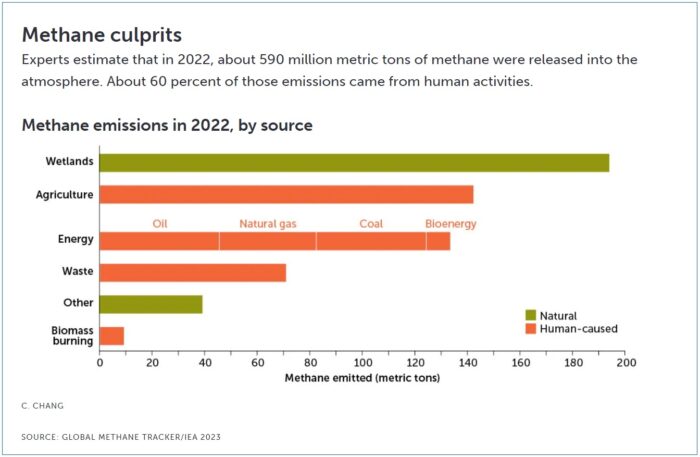Nov 30 2023
Eating Methane
 Methane is the forgotten greenhouse gas (sort of). Often, when discussing how best to reduce anthropogenic climate change, we talk about decarbonizing our electrical and transport sectors, and carbon removal. But methane is also a greenhouse gas, contributing to global warming, and we cannot afford to ignore it. As I discussed recently, methane traps more heat than CO2 but survives for a shorter amount of time in the atmosphere (about 12 years vs hundreds for CO2). Over 20 years it is 80 times worse than CO2, over 100 years it is 28 times worse.
Methane is the forgotten greenhouse gas (sort of). Often, when discussing how best to reduce anthropogenic climate change, we talk about decarbonizing our electrical and transport sectors, and carbon removal. But methane is also a greenhouse gas, contributing to global warming, and we cannot afford to ignore it. As I discussed recently, methane traps more heat than CO2 but survives for a shorter amount of time in the atmosphere (about 12 years vs hundreds for CO2). Over 20 years it is 80 times worse than CO2, over 100 years it is 28 times worse.
The world releases 580 million tons of methane each year, compared to 37 billion tons for CO2 (about two orders of magnitude more). That means over a 20 year timespan, methane has the equivalent greenhouse gas effect as 46 billion tons of CO2 (570 million x 80). In the short term methane is driving global warming a little more than CO2. Perhaps this is an opportunity. CO2 release is essentially the unavoidable consequence of burning fossil fuel. We can mitigate it with carbon capture, but this so far is minimally effective. I only real option is to reduce and then stop the burning of fossil fuel. We are in a race to do this, but it will take decades because the world is dependent on fossil fuel as an energy source.
Methane leaking into the atmosphere, however, is not a completely unavoidable consequence of industry. The largest source of methane emissions is natural, from wetlands (195 million tons). Next is agriculture (142 million) followed closely by the energy sector (135 million). Waste is another 73 million tons, followed by another 45 million from everything else (mostly natural). How can we mitigate this?
For agriculture, farmers can alter the diet of cows and pigs to reduce methane production. They can also use equipment to capture methane from manure storage. Reducing the size of the animal industry, of course, would also reduce emissions. For the energy sector, about two thirds of the emissions come from mining coal and oil, so this will be reduced as we phase out these fossil fuels. But also, best practices can reduce methane release. From the natural gas industry, reducing methane is mostly about reducing leaks in the system. Together, it is estimated that 70% of the methane emissions from fossil fuel use can be eliminated through existing technology. Methane can also be captured from rotting waste.
Just employing all existing technologies and known methods, even without reducing or eliminating existing industries, can significantly reduce anthropogenic methane release. This needs to become a priority. We will then reap the benefits of reducing fossil fuel use and bringing the meat and dairy industries down to sustainable levels (without getting into the debate about exactly what that means).
But even in a best-case scenario, that still leaves a lot of methane being released every year into the atmosphere. Can anything be done about that? Similar to discussions about carbon capture and storage, it may be possible to remove methane from the atmosphere. We already have a “technology” that does this – methanotrophic bacteria. These are bacteria that eat methane, and it is estimated that such bacteria already eat about 30 million tons of methane each year. What if we could increase this amount by an order of magnitude?
There are research efforts to explore this option. One approach is to bioengineer methanotrophic bacteria to be better and faster at eating methane. Of course, the trick will be how to safely deploy these engineered bacteria if we are able to create them. But even maximizing existing methanotrophic bacteria could be helpful. There is still a lot of naturally-produced methane in the world and we may be able to shift the balance. There are farmers, for example, who claim that their cows are methane neutral, because they graze them on grass grown in soil that is rich in methanotrophic bacteria. Those guys feed on the methane produced by other bacteria in the cow GI system. Deploying methanotrophs in vast wetlands and in waste storage may be another approach.
There is also a good side effect of methanotrophs – they eat methane, and in doing so they make usable fuel. Either they can be used as dry biomass once they die, either as fuel or even as fertilizer (potentially replacing fossil-fuel derived fertilizer).
There may also be ways to chemically capture methane. This is chiefly about finding catalysts that promote reactions of methane with other chemicals, pulling it out of the atmosphere and, again, making useful compounds like methanol.
We therefore potentially have three approaches to mitigating methane. We can reduce the release of methane through existing technology just by using best practices. This is a no-brainer, and we should be deploying such solutions as quickly as possible. We can also use methanotrophic bacteria to eat methane – deploying existing bacteria while looking for ways to make them more efficient. Finally we an continue research into chemical ways of removing methane from the atmosphere.
Even with just existing technology, we should be able to reduce the annual addition of methane to the atmosphere by half or so, without too much pain (without reducing or eliminating existing industries). This will significantly slow global warming over the next few decades, buying us some more time to decarbonize our civilization.






